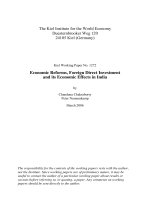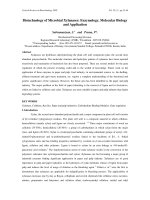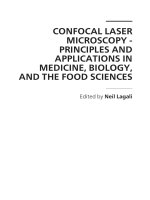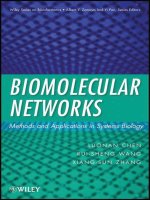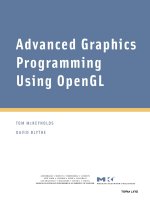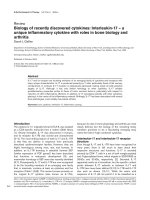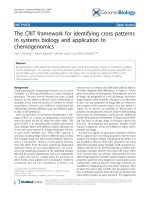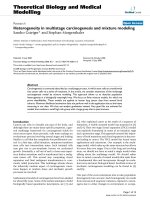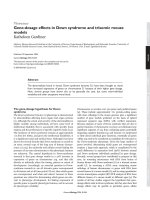Excluded volume effects in molecular biology and extracellular matrix biochemistry biophysical considerations and molecular modeling
Bạn đang xem bản rút gọn của tài liệu. Xem và tải ngay bản đầy đủ của tài liệu tại đây (8.37 MB, 159 trang )
EXCLUDED-VOLUME EFFECTS IN MOLECULAR
BIOLOGY AND EXTRACELLULAR MATRIX
BIOCHEMISTRY: BIOPHYSICAL CONSIDERATIONS
AND MOLECULAR MODELING
HARVE SUBRAMHANYA KARTHIK
MBBS, MMST
A THESIS SUBMITTED FOR THE DEGREE OF DOCTOR
OF PHILOSOPHY IN BIOENGINEERING
DIVISION OF BIOENGINEERING
NATIONAL UNIVERSITY OF SINGAPORE
2008
ii
Acknowledgements
Sincere thanks and gratitude to Prof. Raghunath, Prof. Rajagopalan,
Dr. Ricky Lareu, Dr. Andrew Thomson, Prof. Jiang, Dr. Dimitrios Zeugolis,
and all members of the TML team, Irma Arsianti, Shriju Joshi, Peng
Yanxian, Benny Paula, Wang Zhibo, Felicia Loe, Clarice Chen, Ariel Tan,
Yuan Sy Wong, Pradeep Paul, Lewis Tan, Siah Wanping, Dr. Yin Jian,
Vignesh, Dhawal and last but not the least, my family, who guided,
supported and helped me making every moment of my PhD life memorable.
iii
Table of Contents
Acknowledgements ii
Table of Contents iii
1. List of Figures vi
2. List of Tables viii
3. List of Abbreviations and Symbols ix
4. Summary xi
5. Introduction 1
6. Review of Literature 4
6.1 Macromolecular Crowding and its Effects on DNA and the Nucleus 5
6.2 Macromolecular Crowding and Cellular Homeostasis 6
6.3 Macromolecular Crowding influences Intra-cellular Trafficking 7
6.4 Macromolecular Crowding on Protein-folding and Stability 7
6.5 Macromolecular Crowding Effects on Protein-Aggregation 9
6.6 Macromolecular Crowding Effects on in vitro Biological Processes 10
6.7 Macromolecular Crowding and Enzymatic Processes in vitro 11
6.8 Macromolecular Crowding can trigger Reverse Proteolysis 11
6.9 Mixed Macromolecular Crowding: An Emerging Concept 12
6.9.1 Crowding is a feature seen in all Biological Systems 13
6.9.2 An Evolving Facet of Crowding in Multi-Cellular Organisms: the ECM 15
6.9.3 Macromolecular Crowding in Extremophiles 15
6.9.4 Challenges for Quantitative Estimation of the degree of ‘Crowdedness’ 16
6.9.5 Macromolecular Crowding and Confinement: the Biological Equivalence 18
6.9.6 Summary of Literature 19
7. Objectives and Study Design 20
7.1 Aims and Rationale 20
7.2 Study Design 21
8. Biophysical Approaches to Quantitate Crowding 22
8.1 Aims and Rationale 22
8.2 Study Hypothesis 23
8.3 Biophysical Tools for Crowding Quantification 23
iv
8.3.1 Theory of Dynamic Light Scattering 24
8.3.2 Readouts from a typical DLS Experiment and Interpretation 26
8.3.3 Theory of Zeta Potential 27
8.3.4 Readout from a typical ZP run and Interpretation 28
8.3.5 Materials and Methods 30
8.3.5.1 Sample preparation 30
8.3.5.2 DLS Methods 30
8.3.5.3 Viscosity Measurements 30
8.3.5.4 Zeta Potential Measurements 31
8.4 Results 32
8.4.1 Charged Macromolecules have Significantly Larger Hydrodynamic Radii 32
8.4.2 A Concentration-dependent Decrease in Hydrodynamic Radii 33
8.4.3 A Retrograde Approach from the “Self-Crowding point” 34
8.4.4 Mixed Macromolecular Crowding: PVP360 enhances Fc70 Multimerization 35
8.4.5 Surface Charge Characterization of Macromolecules 36
8.5 Discussion 37
9. Macromolecular Crowding of Molecular Biology Reactions 42
9.1.1. Biomolecular Reactions and the Need for Crowding 42
9.1.2. RT-PCR as a Model for Testing Crowding Effects 43
9.1.3. Rationale of Crowding the RT-PCR 45
9.1.4 Aims 46
9.1.5 Study Hypotheses 46
9.2 Materials and Methods 47
9.2.1. General Materials. 47
9.2.2. Thermostability Screening of Macromolecules. 47
9.2.3. RNA Extraction 47
9.2.4. Reverse Transcription Reaction 48
9.2.5. Polymerase Chain Reaction 48
9.2.6. Processivity Experiments 49
9.2.7. Agarose Gel Electrophoresis 49
9.3. Results 51
9.3.1 Sensitivity 51
9.3.2 Specificity 54
9.3.3. Processivity of Taq Polymerase and Reverse Transcriptase 55
v
9.3.4 PCR Product Yield is enhanced under Crowded Conditions 57
9.3.5 Crowding stabilizes Pre-stressed Enzymes against Heat 59
9.4 Discussion 60
10. Semi-Empirical Modeling of Crowding Nucleic Acid Interactions 64
10.1 Introduction 64
10.2 Aims and Rationale 66
10.3 Hypothesis 66
10.4 Materials and Methods 67
10.4.1 Real-time Measurement of DNA Hybridization 67
10.4.2 Molecular Dynamics Simulations 68
10.5 Results 70
10.5.1 Rationale of Modeling MMC as Macromolecular Confinement 70
10.5.2 Double-stranded DNA is stabilized at Temperature Cycles of a typical PCR 71
10.5.3 In vitro Crowding enhances Thermal Stability of Nucleic Acids 77
10.5.4 Macromolecular Confinement enhances Hydrogen 78
10.5.5 In silico Confinement Models predict Structural Stabilization 80
10.5.6 MMC enhances Duplex Formation of Single-stranded Hair-pin 81
10.6 Discussion 83
10.6.1 MMC drives Duplex Formation from Nucleic Acid Single Strands 83
10.6.2 Mixed MMC greatly enhances DNA-thermal Stabilizing Effects 84
10.6.3 A Combined in vitro-in silico Approach 86
10.6.4 Crowding Effects by Confinement 87
11. Macromolecular Crowding of in vitro Cell Culture 89
11.1 Rationale and Aims 89
11.1.1 Collagen Biosynthesis 89
11.1.2 Hypotheses 91
11.2 Experimental Design, Readouts and Interpretation 92
11.3 Materials and Methods 92
11.4 Results 95
11.5 Discussion 100
12. Final Conclusions and Outlook for the Future 104
13. References 106
Appendix (publications and patent information)
vi
1. List of Figures
1. A schematic illustration of the various extremophiles found on earth
2. Crowded state of cytoplasm in eukaryotic and E. coli cells
3. Crowding principle
4. Crowded environments drive protein folding
5. In vitro biology: Illustrating the shortcomings of current in vitro cell culture
6. Reverse proteolysis
7. Crowding in the ECM
8. Dependence of the folding rates as a function of concentration and the radius
9. A schematic outlay of the study design
10. A schematic outlay of the biophysical approach to quantify crowding
11. The set up of a dynamic light scattering experiment.
12. A DLS Instrument for collecting scattered light
13. A typical DLS readout
14. Electric potential profile
15. A schematic representation of the electrode set-up
16. Charged Macromolecules have larger hydrodynamic size than neutral
17. The ‘self-crowding’ phenomenon
18. Hydrodynamic radii: Maxima and Minima
19. Mixed Macromolecular Crowding
20. Mean negative zeta potentials of anionic macromolecules
21. The contribution of electrostatic exclusion of anionic macromolecules
22. A schematic illustration of reverse transcription in vivo
23. A schematic to show the target molecular biology reactions
24. Macromolecular crowding enhances sensitivity of RT-PCR (Amplification)
25. Macromolecular crowding enhances sensitivity of RT-PCR (Dissociation)
26. Amplification plots and dissociation curves of the GAPDH PCR
27. Macromolecular crowding increased primer binding specificity
28. Macromolecular crowding enhances enzyme processivity
29. Macromolecular crowding enhances activity of Taq DNA polymerase
vii
30. Taq DNA polymerase-thermal stability testing
31. A simplified confinement model
32. Real time readings of SG I fluorescence due to 20-mer DNA hybridization
33. Dissociation Curves of 20-oligomer DNA-DNA hybrids
34. Dissociation curves of DNA duplexes between mismatched oligo(20)-mers
35. Snapshots of simulated single DNA-DNA hybrid
36. Dissociation Curves of 20-mer hair-pin DNA-DNA hybrids
37. Schematic representation of Mixed Crowding effects on DNA stability.
38. Collagen biosynthesis in vivo
39. Schematic illustration of the proposed hypothesis
40. Dextran sulfate (DxS) promotes collagen deposition
41. Dose-dependent stimulation of collagen deposition by DxS
42. Immunocytochemical detection of deposited collagen
43. SDS-PAGE of cell fractions from cultures
44. PSS is a greater volume excluder than DxS500
viii
2. List of Tables
1. A schematic illustration of crowding in cellular organelles
2. List of macromolecules tested for their biophysical profiles
3. Charged macromolecules are larger than neutral macromolecules
4. Mean Zeta potentials of macromolecules
5. Comparing the relative diffusion coefficients of DNA and crowders
6. Real-Time monitoring of thermal stability of nucleic acid hybrids
7. Summary of MD Simulations on nucleic acid hybrids
8. Marginal effects of Neutral Dextran 670 on collagen deposition
ix
3. List of Abbreviations and Symbols
aP2, Fatty Acid Binding Protein
Asc, Ascorbic acid
C
T
, Threshold Cycle
° C, degrees Celsius
cDNA, Complementary DNA
DLS, Dynamic Light Scattering
dNTPs, Deoxy-ribose Nucleotide Triphosphates
DxS, Dextran Sulfate
ECM, Extracellular Matrix
EVE, Excluded-Volume Effect
Fc70, Ficoll 70kDa
Fc400, Ficoll 400kDa
FtsZ-GDP, Filament Temperature-Sensitive Mutant Protein Z- GDP
Ȍ, Fractional Volume Occupancy
GAG, Glycosaminoglycan
GAPDH, Glyceraldehyde Phosphate Dehydrogenase
GroEL, Molecular Chaperone Protein
HBSS, Hanks Balanced Salt Solution
K, Kelvin
MMC, Macromolecular Crowding
MM-CK, Muscle Creatinine Kinase
MD, Molecular Dynamics
µm, micrometer
x
nm, nanometer
ND 410, Neutral Dextran 410 kDa
ND 670, Neutral Dextran 670 kDa
R
H
, Hydrodynamic Radius
RT, Reverse Transcriptase
RMSD, Root-Means-Squared-Displacement
PCR, Polymerase Chain Reaction
PDI, Protein Disulfide Isomerase
PEG, Polyethylene Glycol
PSS, Polystyrene Sulfonate
PVP360, Polyvinyl Pyrrolidone 360 kDa
SEM, Standard Error of Mean
SG I, SYBR Green I
T
m
, Melting temperature
TIM, Triose Phosphate Isomerase
ZP, Zeta-(ȗ)- Potential
xi
4. Summary
Macromolecular crowding is a vital biophysical principle governing the structure and
function of all biological systems both at the intra- and extra-cellular levels. Crowding of
biological spaces leads to the excluded volume effect (EVE). This favors macromolecular
association, influences enzymatic reactions and evolutionary structural organization of
living systems. In the current study, EVE was created by dissolving macromolecular
crowders of defined molecular weights and surface charge in physiological solutions.
Quantitative characterisation of crowding molecules was done by Dynamic Light
Scattering, Viscometry and Zeta potential measurements. We found that anionic
macromolecules like dextran sulfate (DxS; 500 kDa) have larger hydrodynamic radii
(~46.3nm) than neutral macromolecules of comparable molecular weight like dextran
(670 kDa; ~21.2nm). However, among the negatively charged crowders, those with a
higher negative surface charge density (and zeta potential) like polystyrene sulfonate
(PSS; 200kDa) showed a massive gain in hydrodynamic radius (21.2nm). Hydrodynamic
radius and negative surface charge therefore are critical determinants of EVE by a
crowder to a ‘test’ molecule. Crowding was applied on in vitro models, namely the
reverse-transcriptase-polymerase chain reaction (RT-PCR) by adding neutral
macromolecules (Ficoll) to the reaction. Sensitivity of the RT-PCR was improved by
~10-fold at an enhanced specificity of amplification. Thermal stability and processivity of
DNA polymerase enzymes were enhanced by crowding demonstrated by synthesis of
longer DNA products. Crowding enhances PCR efficiency and product yield by ~2-fold.
Effects of crowding on the thermal stability of nucleic acid hybrids (critical for many
molecular biology reactions such as RT-PCR), was investigated. Melting temperatures
xii
were increased by 5-8 °C under crowded conditions for DNA-DNA hybrids of different
length, sequence and conformations and DNA:RNA hybrids. Crowding thus enhances
stability of nucleic acid structure in thermally stressed environments. An in silico
modeling based on a Molecular Dynamics platform was done to understand the
mechanics of crowding induced thermal stability of nucleic acid hybrids. Crowding was
found to minimize structural distortion as shown by a 3-fold decrease in Root-Means-
Squared-Deviation and to reduce breaking of hydrogen bonds between complementary
nucleotides in the double helix upon heating to denaturation. The study was then taken to
a higher level of complexity by introducing crowding into fibroblast cultures, a more
complex system than PCR in terms of composition, target biological reactions and read-
outs. We chose extracellular collagen deposition as a read-out, as it is an enzymatically
controlled step. Collagen deposition is very slow in standard non-crowded culture
conditions which represent a bottleneck in tissue engineering applications. Crowding by
negatively charged macromolecules such as DxS and PSS enhanced collagen deposition
by ~10-fold. As expected from biophysical measurements, EVE created by charged
macromolecules and, in turn, collagen deposition, was greater than in the presence of
neutral macromolecules of comparable size. As predicted, PSS led to greater collagen
deposition than DxS due to greater surface charge density. In conclusion, the presented
studies demonstrate the manifold effects of crowding and EVE in molecular biology and
extracellular matrix biochemistry with a wide-range of potential applications in academic
research, industrial R & D and clinical translation.
1
5. Introduction
All living systems are highly crowded (Fulton, 1982). This is true of the interiors
and exteriors – of all cells, whether bacterial, animal, or plant. The Crowding element is
derived from macromolecules such as proteins, carbohydrates, lipids and nucleic acids,
that form macromolecular complexes and supra-molecular assemblies such as cellular
organelles and membranes (Minton, 2000a) so much so that up to 40% of the cytoplasmic
volume is occupied by macromolecules (Ellis & Minton, 2003; Ebel & Zaccai, 2004).
Viruses, archaea and prokaryotes considered the earliest life forms, have been found to
have crowded structural and functional units. Further, the archaea and prokaryota have
been found to be extremophilic, i.e. they have the ability to survive under extremely
harsh conditions of temperature (thermophiles, hyperthermophiles and psychrophiles),
salt (halophiles), pH (acidophiles and alkaliphiles), aridity (xerophiles), hydrostatic
pressure (peizophiles) and so on (Fig. 1).
2
Figure 1. A schematic illustration of the various extremophiles found on earth (Adapted with
permission from Roberto Osti Illustrations, illustrated in an article by Madigan et al., 1997).
The extremely hardy nature of these organisms has been explained as being due to many
factors. One of them is Macromolecular Crowding. Still in the hypothetical domain, this
attribution needs to be thoroughly investigated experimentally and the mechanisms
explained. Crowding functions by way of the excluded-volume effect (EVE). Excluded
volume refers to the volume of a solution that is excluded to the center of mass of a ‘test’
molecule by the presence of one or more background (crowder) molecules in the
medium. The volume exclusion effect is greatest between like-sized crowder and ‘test’
molecules. Fractional volume-occupancy (Ȍ) denotes the fraction of the total volume
occupied by macromolecules. Structurally and chemically, the macromolecule could be
derived from carbohydrate/ protein/nucleic acid/lipid family or their analogues like the
glycosaminoglycans. However, the Crowding behavior is entirely dependent on the
3
physical property of the macromolecule. Biological macromolecules such as enzymes
and proteins function in highly crowded environments. The total concentration of protein
and RNA inside bacteria like E. coli is in the range of 300-400 g/l. Crowding has multiple
effects in biological systems in vivo. They include effects on reaction rates and equilibria,
macromolecular self-assembly, genome structure and function as well as folding of
biopolymers (eg. nucleic acids and proteins). These resulting effects are so large, that
many estimates of reaction rates and equilibria made with uncrowded solutions in the test
tube differ by orders of magnitude from those of the same reactions operating under
crowded conditions within cells or the extracellular compartment (Minton, 2005).
However, EVE and its roles have not been appreciated in the biological domain and
applications have yet to be fully discovered (Ellis, 2001b). The cell culture is a typical
example wherein the cells anchored to the culture plate find themselves bathed in an
ocean of medium that is hardly representative of the in vivo conditions. Biological
reactions in such in vitro conditions proceed at significantly slower rates than their in vivo
counterparts. Thermodynamically, volume exclusion lowers the configurational and
conformational freedom (entropy) and this leads to raised basal free energy of the
reactant macromolecules and a number of downstream effects (Hall & Minton, 2003).
These may be identified as (1) folding of proteins into native states optimal for function
(Cheung et al. 2005) (2) stronger macromolecular transition complexes with longer half-
lives (eg. enzyme-substrate) leading to more products and (3) buffering effect of crowded
environments on biological function under conditions of adverse pH, temperature or ionic
strength
(Goobes et al. 2003).
4
6. Review of Literature
The role of Macromolecular Crowding (MMC) in shaping the cell and extra-
cellular environments and its influence on most biological processes both at the intra- and
extra-cellular levels in vivo are the focus of many current studies.
Figure 2. Crowded state of cytoplasm in eukaryotic and E. coli cells (adapted from The
machinery of life by Goodsell D.S., Springer-Verlag, 1993 with kind permission of Springer
Science and Business Media; see reference for full citation).
In a medium containing multiple species of soluble macromolecules, even if no
species is found at high concentrations, but when considered collectively all the different
species account for a significant fraction (20-30%) of the volume of the medium; then
this medium is called “crowded” instead of being “concentrated” (Minton & Wilf, 1981;
Zimmerman, 1993; Rivas et al. 2004). The term ‘Macromolecular Crowding’ was thus
introduced to underscore that the effect of Crowding by large molecules is not significant
on the activity of metabolites and small ions but on other large molecules; that is, the
effect is exerted by large molecules on like-sized large molecules (Fig. 3).
Ribosome
Protein
RNA
Microtubule
Intermediate
filament
Actin
filament
Eukaryotic cell
E. coli cell
5
Figure 3. Crowding principle: At thermal equilibrium of the solution, the total excluded volume
to a ‘test’
*
(red) molecule of size comparable with the crowders (black) is a summation of the
unavailable volume (dark-blue) and the occupied volume (black). This is due to the geometric
shape constraints of the crowders modeled here as rigid hard spheres.
6.1 Macromolecular Crowding and its Effects on DNA and the Nucleus
Crowding determines genome structure and function by its effects on both the
organization of DNA into nucleosomes by folding-packaging and the interactions
between DNA and histones (Zimmerman, 1993; Zimmerman & Murphy, 1996).
Crowding has been shown to contribute to enhance the free energy of binding between
two individual DNA strands or between a protein and a DNA interaction (Goobes et al.
2003; Record et al. 1998). Crowding thus influences the structural and functional
integrity of nuclear compartments in vivo (Hancock, 2004). Moreover, it has been
reported that the initiation of DNA replication depends on nucleus formation (Walter et
*
The ‘test’ molecule refers to the molecule that will be crowded by the crowding macromolecules
6
al. 1998; Depamphilis, 2000), which emphasizes the role of Crowding for the operation
of the replication machinery, as shown by in vitro experiments (Walter et al. 1998; Jarvis
et al. 1990).
6.2 Macromolecular Crowding and Cellular Homeostasis
The living cell depends entirely on the enzyme-driven metabolic reactions as
suggested by Arthur Kornberg as one of the ten ‘commandments’ in enzymology
(Kornberg, 2003). The seventh ‘commandment’, according to Kornberg describes the
crowded nature of the cell and a reminder that all enzymatic reactions in vitro with cell-
free systems need to include this crowding element. All the enzymes function at optimal
conditions of salt concentration, pH and temperature. However, if any of these conditions
are altered, the enzyme function is perturbed. However, under crowded conditions the
enzymatic activity is still maintained. As an example, experiments were done on the nick-
translation and polymerizing functions of E. Coli DNA polymerases (Zimmermann and
Harrison, 1987). The optimal salt (KCl) concentration for nick-translation under non-
crowded conditions was 0.1M. However when the salt concentration was increased by 3-
fold, the enzyme activity was inhibited. But under crowded conditions (due to Ficoll 70),
the enzyme activity was still well detectable at 0.3M salt concentrations. This was
explained to be due to the sustained binding of the polymerases to their template-primer
complexes under Macromolecular Crowding conditions even in highly unfavorable
conditions (in this case, the ionic strength) that are introduced, the enzymes remaining
active and hence widening the range of conditions/environments in which the cell can
remain viable.
It has also been found that Crowding effects resulting from changes in the
amount of water seem to compensate for the effects of changes in cytoplasmic K
+
ions
7
and contribute to maintaining protein–nucleic-acid equilibria and kinetics in the range
required for function in vivo
(Record et al. 1998).
6.3 Macromolecular Crowding influences Intra-cellular Trafficking
The viscoelastic properties of a cell determine how it reacts to the environment
(Guigas, 2007a). Macromolecular Crowding contributes to the viscoelasticity of the
cytoplasm and nucleoplasm which results in anomalous sub-diffusion
†
of macrosolutes
(Weiss et al. 2004; Guigas et al. 2007) leading to slow apparent translational diffusion of
molecules in the cytosol (Elowitz, 1999). Crowding has also been associated with cell
signal transduction pathways (Bray, 1998). Crowding in cells greatly favors
macromolecular associations involved in signal transmission, frequently increasing the
binding strength by at least an order of magnitude (Wilf & Minton, 1981).
6.4 Macromolecular Crowding on Protein-folding and Stability
Crowding influences protein stability by driving proteins into compact from
expanded states and enhancement of self- and hetero-associations of protein
macromolecules provided there is a tendency for the interacting molecules to associate
(Ellis 2001). For instance, the dependence of oxygen affinity of erythrocytes containing
sickle cell hemoglobin can be quantitatively explained by Crowding induced-steric
repulsion between hemoglobin molecules (Minton, 1976). The increased thermal stability
of proteins under crowded conditions has been shown by many in vitro experiments.
Crowding tends to force binding of the enzyme to the substrate and increased strength of
binding could, in principle, stabilize both components to denaturation (Zimmerman &
†
A phenomenon when the mean-squared-displacement of a diffusing molecule does not increase linearly
with time
8
Harrison, 1987). Theoretical considerations (Cheung et al. 2005) have predicted that
Crowding can enhance the thermal stability of the folded state relative to that of the
unfolded state (Fig. 4). Crowding also influences the rate of protein folding. It has been
found that the refolding of hen lysozyme occurs in two distinct separate fast and slow
tracks (Radford et al. 1992; Dobson et al. 1994; Matagne et al. 1997; Kulkarni et al.
1999). Another study
(Van den Berg, 1999b)
reported that, in experiments done on the
oxidative refolding of hen lysozyme under crowded conditions, while there is
acceleration of fast- track refolding rate by 2- to 5-fold relative to refolding in dilute
solution, it could decrease slow-track refolding rate by nearly 50%.
Figure 4. Crowded environments (b) contribute to protein folding into compact state by reducing
the conformational entropy for the unfolded state (a) (Modified from Cheung et al., PNAS, 2005).
The relative unfolding of one population of proteins could affect the folding of other
proteins in the same environment and Crowding acts as a regulator of the thermal
stability of proteins
(Despa et al. 2005). The thermal stability of the proteins found in the
interior of an eye lens increases with concentration (Steadman et al. 1989), and the
exceptional heat stability of an intact lens has been attributed in part to the stabilizing
effects of Macromolecular Crowding inside the lens cell (Bloemendal et al. 2004). In the
a
Folded
state
b
Unfolded state
9
in vitro scenario, the thermal stability of Į-lactalbumin is increased as indicated by a raise
in melting temperature by 25–30 °C by encapsulation in a silica matrix (Eggers &
Valentine, 2001), an example also of the ‘caging effect’ that Crowding exerts on proteins
(Thirumalai, 2003). Studies of Crowding effects on the refolding rates of proteins have
been done on reduced lysozyme (van den Berg et al. 2000; Zhou et al. 2004), glucose-6-
phosphate dehydrogenase (Li et al. 2001), glyceraldehyde-3-phosphate dehydrogenase
(Ren et al. 2003), protein disulfide isomerase (PDI)
(Li et al. 2001), and GroEL (Galan
et al. 2001).
6.5 Macromolecular Crowding Effects on Protein-Aggregation
Although the above mentioned works have shown that Crowding enhances
protein folding to the native state, there have also been reports of Crowding-induced
aggregation (van den Berg et al. 1999b; Ellis, 2001b). Several experiments show that the
oligomerization of actin (Lindner & Ralston, 1997), spectrin (Lindner & Ralston, 1995),
tubulin (Rivas et al. 1999) and FtsZ-GDP (Rivas et al. 2001) were augmented under
crowded conditions, as well as the self-association of fibrinogen (Rivas et al. 1999). In
the intra-cellular context, it was shown that the association of ribosomal particles was
increased under crowded conditions (Zimmerman & Trach, 1988b). The aggregation has
been explained as being due to increases in the thermodynamic activity of partially folded
polypeptide chains, and this effect being particularly pronounced for small as well as
slow-folding chains (Ellis, 2001b). For slow-folding chains, it was shown that the
protein-folding catalyst PDI was especially effective in preventing proteins such as
reduced hen lysozyme from aggregating under crowded conditions (van den Berg et al.
1999b), due to the enhancement of PDI’s chaperone function by Crowding. The
10
association of chaperones with partly folded chains might be enhanced under crowded
conditions, thus reducing the encounter rate of these chains with each other and hence the
probability of them aggregating (Ellis, 2001b).
6.6 Macromolecular Crowding Effects on in vitro Biological Processes
The realization of the importance of Macromolecular Crowding notwithstanding,
many studies continue to be conducted in in vitro under uncrowded conditions. For
example, in the cell culture the total concentration of macromolecules is typically 1-10
mg/ml and Crowding effects are negligible (Ellis, 2001b). Thus we can appreciate that
current in vitro culture media are actually “an ocean of dilution” (Fig. 5). However,
Crowding effects needed to be taken into account when attempting to relate biochemical
and biophysical observations made in vitro to physiological processes observed in vivo
and therefore Crowding is an important parameter to be applied in vitro. Further,
excluded-volume effects in physiological media demand careful consideration when
associating a role in vivo for any macromolecular reaction conducted in vitro (Minton,
2001). An important observation here is that many estimates of reaction rates and
equilibria made with uncrowded conditions in vitro differ by orders of magnitude from
those made under crowded conditions in vivo (Ellis, 2001b).
Figure 5. In vitro biology: the shortcomings of current
in vitro cell culture: An “ocean of dilution” illustrating
how the newsprint can be easily read through the flask
containing dilute culture medium (Picture courtesy:
Prof. M. Raghunath, Tissue Modulation Laboratory,
NUS).
11
Crowding effects can be replicated and examined in in vitro studies by using single or
combinatorial solutions of ideal Crowding agents, i.e. those that are chemically inert,
highly pure, water-soluble, of varied shapes (ideally globular) and with a molecular
weight range of 50-500 kDa such as dextrans and their derivatives, Ficolls or inert
proteins (Munishkina et al. 2004).
6.7 Macromolecular Crowding and Enzymatic Processes in vitro
Crowding effects on the function of enzymes have been studied in vitro. As was
mentioned before, studies on DNA polymerases (Zimmerman & Harrison, 1987) of E.
coli showed that Macromolecular Crowding enhanced the binding of the polymerases to
the template-primer complex and increased enzyme activity even at highly inhibitory
conditions of high ionic strength. Hence Crowding helps extend the range of
environments in which the enzyme still remains functional.
6.8 Macromolecular Crowding can trigger Reverse Proteolysis
An interesting effect of Macromolecular Crowding is observed called as reverse
proteolysis. Crowding enhances the association of macromolecules into compact
complexes, and it was found that some enzymes which catalyze degradative reactions
such as limited proteolysis in vitro might catalyze the reverse reaction in vivo, i.e. cause
reverse proteolysis (Somalinga & Roy, 2002; Fig. 6), and thus function as synthetic rather
than degradative enzymes in vivo. This study showed that Crowding could trigger
transformation of a non-covalent protein complex obtained by limited proteolysis to the
native (covalent) form, but only if the formation of the native protein resulted in
12
significant compaction leading to substantial volume reduction, thereby enabling greater
translational entropy for the compacted protein under crowded conditions.
Figure 6. Reverse proteolysis: Crowding causes a proteolytic enzyme to function as a synthetic
enzyme (Adapted from Somalinga et al. JBC. 2002).
6.9 Mixed Macromolecular Crowding: An Emerging Concept
Conceptually, this is an extension of the principle of Crowding that takes origin
from earlier findings that the cellular environment is a collection of a variety of different
macromolecules within the same confined space; different types of inert macromolecules
(in terms of size, shape and surface charge) in varying amounts could in principle be
added to cell cultures to more accurately mimic the in vivo conditions. Studies conducted
to test this theory have produced interesting results. For example, Du et al. (2006)
observed that the refolding yield of rabbit muscle creatine kinase (MM-CK) in the
presence of a Mixed Crowding agent (in which the weight ratio of calf thymus DNA to
Ficoll 70 is 1:9) increased by up to 23% as compared to single Crowding agents. The
refolding rate of MM-CK was also greatly accelerated by Mixed as opposed to single
Crowding agents. It can thus be concluded that Mixed Macromolecular Crowding
13
conditions are arguably more favorable for protein folding and also better mimic the
physiological environment than single Macromolecular Crowding conditions.
6.9.1 Crowding is a feature seen in all Biological Systems
The native structures of proteins and other intracellular moieties are usually
compact and most nuclear compartments are spherical or quasi-spherical in shape (Rivas
et al. 2001). DNA occurs in highly compact structures such as nucleoids (prokaryotes) or
nucleosomes (Watson et al. 1987) and condensed rather than extended DNA is possibly
the more efficient and a more physiologically relevant state of DNA (Sikorav & Church,
1991). In multi-cellular organisms like vertebrates, we see that the intra-cellular crowded
environment develops into a more ordered structure. Thus the cellular interior is nano-
compartmentalised by the microtubules, intermediate filaments and actin fibers that form
the cytoskeletal framework. The cytoskeletal framework in fact provides the
“Macromolecular Confinement”, an effect equivalent to Crowding (Cheung et al. 2005).
Cellular nano-compartmentalisation is evident by the formation of cellular organelles
such as the nucleus, mitochondrion, endoplasmic reticulum, and Golgi bodies. For a
typical eukaryotic cell, the nucleus has been found to have a total macromolecular
concentration of 400 mg/ml, the cytoplasm 50-400 mg/ml, the ER 100mg/ml and
mitochondria a substantial 270-560 mg/ml (see Table 1). However, it has to be noted that
the macromolecules making up this number are a diverse collection of molecules
differing in size, shape and net surface charge sub-serving different functions but together
occupying a significant fraction of the total volume. The volume of exclusion to a given
molecule however, depends on its size relative to the Crowding molecules. Thus the
concentrations indicated may not be exact measures of the volume excluded. This is
